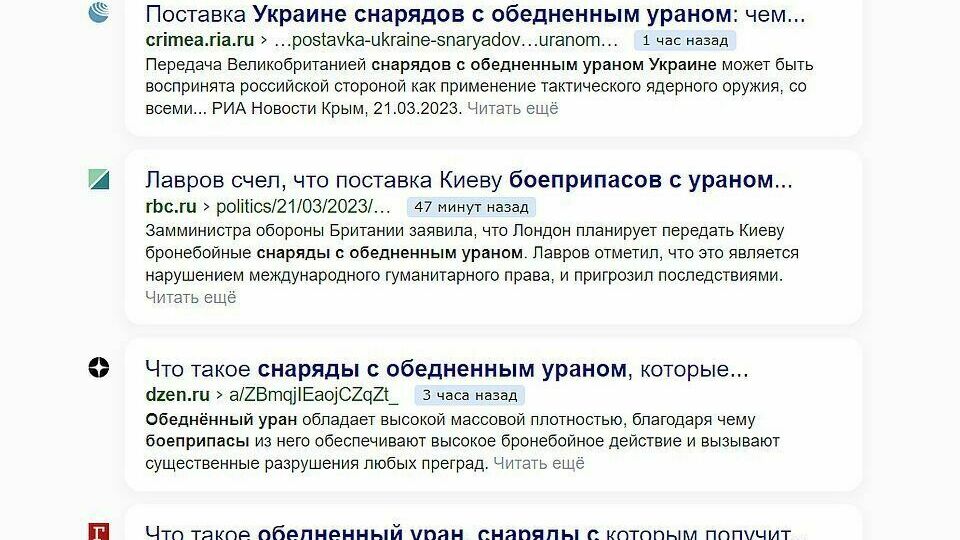Posted 23 марта 2023, 10:14
Published 23 марта 2023, 10:14
Modified 23 марта 2023, 10:24
Updated 23 марта 2023, 10:24

A weapon with a secret: how dangerous depleted uranium is for people and the environment
A real storm in the Russian media was caused by a message about the supply of depleted uranium shells to Ukraine. Many politicians and journalists have called this the approach of a "nuclear apocalypse", arguing that depleted uranium is an environmental pollutant, and despite the fact that it is less radioactive than natural, it still retains its toxicity associated with the source element. Moreover, in large doses, the main human target organ for it is the kidneys, in the tubules of which this metal causes potentially fatal necrosis. It is also known that Putin said that Russia would be forced to respond to such supplies.
Ukraine should be wary of contamination of its soils with uranium
In the West, they actively refute the claims about the danger of depleted uranium.
For example, the British Ministry of Defense has already accused Russia of misinformation about this by issuing a special statement. It states that depleted uranium has been used for decades as an element for the production of ammunition for heavy weapons, and that this component is standard, having nothing to do with nuclear weapons. The ministry pointed out that such shells also have increased effectiveness in defeating modern armored vehicles and tanks. Such shells, in particular, were actively used by the American army during the Iraq War in 1991. Moreover, Western sources are sure that there are similar shells in the arsenal of the Russian army.


However, the Russian media do not believe this version. Thus, TASS in its message refers to the words of the Russian Ambassador to Washington Anatoly Antonov, who commented on the claims that depleted uranium ammunition is a common type of weapons that does not pose increased danger:
"It's really difficult to comment on this kind of nonsense. American officials have broken another bottom with their irresponsible statements. A continuous stream of deadly weapons is coming to Ukraine, with the help of which civilians, residential areas, schools, hospitals, kindergartens are being destroyed. But even this is not enough for Western monsters. Now, apparently, they want to supply depleted uranium shells to the Kiev Nazis!".
Chinese experts, who, in an article published by the Global Times, write, did not stand aside either:
"In fact, it is Ukraine, which survived the accident with a leak at the Chernobyl nuclear power plant, that should be wary of depleted uranium. Ukraine is one of the world's most important producing and exporting countries of cereals and oilseeds. The potential dangers and environmental pollution caused by uranium cannot be ignored."
Depleted uranium is no more dangerous than tank armor or battery
So what is this depleted uranium?
Network analyst Yuri Christensen explains in his blog:
"Depleted uranium is obtained from natural uranium by separating radioactive isotopes from it. That is, isotopes are the target for use in the nuclear industry, and depleted uranium remains useless waste products. Depleted uranium is used in civilian industry. If you flew passenger planes, there could be up to one and a half tons of depleted uranium counterweights next to you. It is cheaper for the manufacturer and safe for passengers. The time spent near depleted uranium, for negative consequences for the body, is thousands and thousands of human lives, since only low-intensity gamma radiation can pose a danger. Therefore, it is fearlessly used in the design of modern aircraft.
Tungsten alloys used to be used in armor-piercing shells. They're fine, except for two things. The first is the high price. And the second - a sub-caliber "scrap" made of tungsten, piercing the armor, flattens at the end, forming a "fungus". Depleted uranium alloys lack both disadvantages. They are cheaper and have the property of "self-sharpening" when breaking through a thick layer of armor. Armor penetration is growing at the same time as taxpayers' money is being saved.


And in general, many do not know that the latest Abrams modifications have armor made of depleted uranium, which are prohibited for export.
Yes, the uranium oxide formed during the penetration of the armor is toxic when it enters the lungs. But a tank sprayed in the air is no less toxic. For those who are in close proximity to the interaction of the uranium core and armor, the probability of cancer from the ingress of uranium oxide into the lungs is orders of magnitude lower than the probability of dying from the consequences of armor penetration. Even taking into account the fact that in this place you can inhale molybdenum compounds from tank armor (this is a poison with a lethal dose of 0.05 g), or super carcinogenic lead from a tank battery, or no less toxic tungsten oxide, and various other rubbish. Because in order to die from cancer, you must first survive the destruction of the tank, sitting in the tank, or on the armor.
This leads to a simple conclusion. There is no way to destroy a tank without releasing a huge amount of toxins and carcinogens. Well, not to mention that wars are always death..."